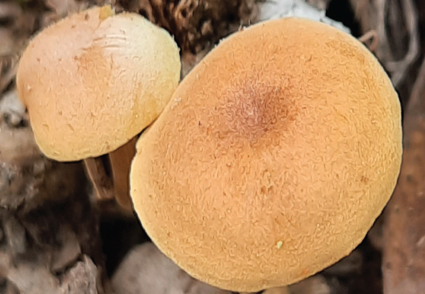Abstract
A novel species, Xerophorus pakistanicus, has been identified from Southern Punjab, Pakistan, based on morphological characters and molecular phylogenetic analyses. Xerophorus pakistanicus is characterized by a brown to dull orange, parabolic to campanulate pileus, a stipe turning light yellowish brown on handling, an absence of an annulus, amygdaliform to oblong basidiospores, utriform to pyriform caulocystidia, and the presence of clamp connections only in the stipitipellis. A phylogram, based on the combined nrITS-28S dataset, was constructed to assess the phylogenetic position of our strain, resulted Xerophorus pakistanicus sp. nov. within the genus Xerophorus. We present the new species with an illustrated morphological description and comparison with similar morphological or phylogenetically related species. This is the first record of the genus Xerophorus from Asia. A key to the known species of Xerophorus is also provided.
References
- Bas, C. (1969) Morphology and subdivision of Amanita and a monograph of its section Lepidella. Persoonia 5: 96–97.
- Darriba, D., Taboada, G.L., Doallo, R. & Posada, D. (2012) JModelTest 2: more models, new heuristics and parallel computing. Nature Methods 9: 772. https://doi.org/10.1038/nmeth.2109
- Edgar, R.C. (2004) MUSCLE: multiple sequence alignment with high accuracy and high throughput. Nucleic Acids Research 32: 1792–1797. https://doi.org/10.1093/nar/gkh340
- Gardes, M. & Bruns, T.D. (1993) ITS primers with enhanced specificity for basidiomycetes—application to the identification of mycorrhizae and rusts. Molecular Ecology 2: 113–118. https://doi.org/10.1111/j.1365-294X.1993.tb00005.x
- Kaygusuz, O. & Şengül, MŞ. (2021) Xerophorus donadinii (Bon) Vizzini, Consiglio & M. Marchetti (Callistosporiaceae: Agaricales) from Mediterranean Region of Turkey. Sinop Üniversitesi Fen Bilimleri Dergisi 6: 143–151. https://doi.org/10.33484/sinopfbd.1012076
- Lavorato, C., Vizzini, A., Ge, Z.W. & Contu, M. (2015) Redescription of Clitocybe umbrinopurpurascens (Basidiomycota, Agaricales) and revision of Neohygrophorus and Pseudoomphalina. Phytotaxa 219: 43–57. https://doi.org/10.11646/phytotaxa.219.1.3
- Lodge, D.J., Padamsee, M., Matheny, P.B., Aime, M.C., Cantrell, S.A., Boertmann, D., Kovalenko, A., Vizzini, A., Dentinger, B.T.M., Kirk, P.M., Ainsworth, A.M., Moncalvo, J.-M., Vilgalys, R., Larsson, E., Luecking, R., Griffith, G.W., Smith, M.E., Norvell, L.L., Desjardin, D.E., Redhead, S.A., Ovrebo, C.L., Lickey, E.B., Ercole, E., Hughes, K.W., Courtecuisse, R., Young, A., Binder, M., Minnis, A., Lindner, D.L., Ortiz-Santana, B., Haight, J., Laessoe, T., Baroni, T.J., Geml, J. & Hattori, T. (2014) Molecular phylogeny, morphology, pigment chemistry and ecology in Hygrophoraceae (Agaricales). Fungal Diversity 64: 1–99. https://doi.org/10.1007/s13225-013-0259-0
- Malysheva, E.F., Morozova, O.V. & Contu, M. (2011) New combinations in Clitocybula: a study of cystidiate Pseudoomphalina species (Basidiomycota, Agaricomycetes). Sydowia 63: 85–104.
- Miller, M.A., Holder, M.T., Vos, R., Midford, P.E., Liebowvitz, T., Chan, L., Hoover, P. & Warnow, T. (2010) The CIPRES Portals. Available from: https://www.phylo.org/ (accessed: 14 December 2022).
- Munsell (1975) Munsell soil color charts. Macbeth Division of Kollmorgen Corporation. Baltimore, Maryland.
- Raj, K.A., Latha, K.D., Leelavathy, K.M. & Manimohan, P. (2019) Anupama: a new genus of Biannulariaceae (Agaricales) from tropical India. Mycological Progress 18: 659–669. https://doi.org/10.1007/s11557-019-01479-1
- Rambaut, A. (2014) FigTree 1.4. 2 software. Institute of Evolutionary Biology, University of Edinburgh.
- Raza, M., Cai, L., Abbasi, M.W., Tariq, M. & Wijayawardene, N.N. (2021) https://www.fungiofpakistan.com: a continuously updated online database of fungi in Pakistan. Database 2021: baab080.
- Raza, M., Cai, L., Abbasi, M.W., Hafeez, R., Tariq, M., Kirk, P.M. & Wijayawardene, N.N. (2022) The first updated checklist of novel fungi in Pakistan (1947–2021). MycoAsia-Journal Modern Mycology 3: 72.
- Ronquist, F., Teslenko, M., Van Der Mark, P., Ayres, DL., Darling, A., Höhna, S., Larget, B., Liu, L., Suchard, M.A. & Huelsenbeck, J.P. (2012) MrBayes 32: efficient Bayesian phylogenetic inference and model choice across a large model space. Systematics Biology 61: 539–542. https://doi.org/10.1093/sysbio/sys029
- Sánchez-García, M. & Matheny, P.B. (2017) Is the switch to an ectomycorrhizal state an evolutionary key innovation in mushroom-forming fungi? A case study in the Tricholomatineae (Agaricales). Evolution 71: 51–65. https://doi.org/10.1111/evo.13099
- Sánchez-García, M., Henkel, T.W., Aime, M.C., Smith, M.E. & Matheny, P.B. (2016) Guyanagarika, a new ectomycorrhizal genus of Agaricales from the Neotropics. Fungal Biology 120: 1540–1553. https://doi.org/10.1016/j.funbio.2016.08.005
- Sarwar, Z.M., Sajjad, M., Farhan, M., Najam-ul-Hassan, M., Shahzad, M.F., Binyameen, M. & ur Rehman, H. (2021) Taxonomy and distribution of agriculturally important plusiinae (Lepidoptera: Noctuidae) from southern Punjab, Pakistan. Saudi Journal of Biological Sciences 28: 5720–5727. https://doi.org/10.1016/j.sjbs.2021.06.005
- Shi, X.F., Yu, F.Q., Zhang, R. & Liu, P.G. (2016) Two new species of Suillus associated with larches in China. Mycotaxon 131: 305–315. https://doi.org/10.5248/131.305
- Singer, R. (1944) New genera of fungi. Mycologia 36: 358–368. https://doi.org/10.1080/00275514.1944.12017559
- Stamatakis, A. (2014) RAxML version 8: a tool for phylogenetic analysis and post—analysis of large phylogenies. Bioinformatics 30: 1312–1313. https://doi.org/10.1093/bioinformatics/btu033
- Vellinga, E.C. (2001) Agaricaceae. In: Noordeloos, M.E., Kuyper, T.W. & Vellinga, E.C. (eds.) Flora Agaricina Neerlandica 5. Rotterdam: A.A. Balkema Publishers, 220 pp.
- Vizzini, A., Consiglio, G., Marchetti, M. & Alvarado, P. (2020) Insights into the Tricholomatineae (Agaricales, Agaricomycetes): a new arrangement of Biannulariaceae and Callistosporium, Callistosporiaceae fam. nov., Xerophorus stat. nov., and Pleurocollybia incorporated into Callistosporium. Fungal diversity 101: 211–259. https://doi.org/10.1007/s13225-020-00441-x
- White, T.J., Bruns, T., Lee, S. & Taylor, J.W. (1990) Amplification and direct sequencing of fungal ribosomal RNA genes for phylogenetics. In: Innis, M.A., Gelfand, D.H., Sninsky, J.J. & White, T.J. (Eds.) PCR protocols: a guide to methods and applications. Academic Press, New York, pp 315–322. https://doi.org/10.1016/B978-0-12-372180-8.50042-1
- Zhao, R.L., Karunarathna, S.C., Raspe, O., Parra, L.A,, Guinberteau, J., Moinard, M., Kesel, A.D., Barroso, R., Courtecuisse, R., Hyde, K.D., Guelly, A.K., Desjardin, D.E. & Callac, P. (2011) Major clades in tropical Agaricus. Fungal Diversity 51: 279–296. https://doi.org/10.1007/s13225-011-0136-7


